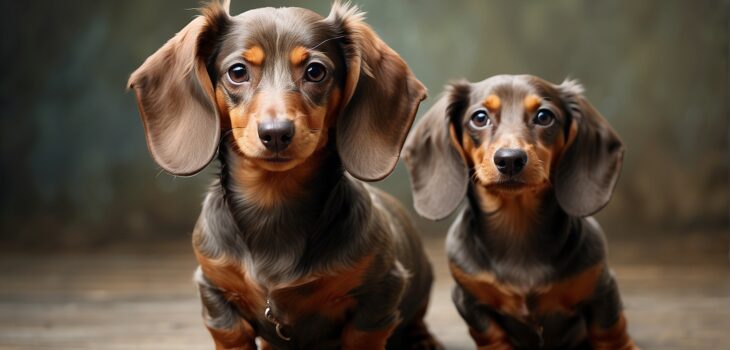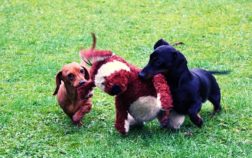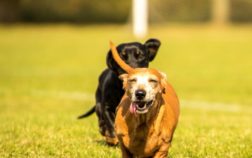If you’re considering bringing a furry friend into your home, the question of shedding is likely to cross your mind. When it comes to Dachshunds, or “wiener dogs” as they’re affectionately known, understanding their shedding tendencies is crucial. In this article, we’ll explore the topic of Dachshund shedding and provide you with some valuable insights into whether or not these adorable, long-bodied pups leave a trail of fur behind. So, if you’re curious about the shedding habits of Dachshunds, keep reading to find out all you need to know.
Short-Haired Dachshunds
Coat Characteristics
Short-haired Dachshunds, also known as Smooth Dachshunds, have a sleek and shiny coat that lies close to their body. This type of coat is smooth to the touch and requires minimal maintenance compared to other Dachshund varieties.
Shedding Frequency
Short-haired Dachshunds are moderate shedders. While they may not shed as much as some other breeds, they still do shed regularly throughout the year. Shedding frequency can vary depending on factors such as genetics, health conditions, and grooming habits.
Managing Shedding
To manage shedding in short-haired Dachshunds, regular grooming is essential. Brushing your Dachshund’s coat at least once a week will help remove loose hairs and prevent them from ending up all over your furniture and clothing. Additionally, providing a healthy diet and ensuring your Dachshund is in optimal health can help minimize excessive shedding.

Long-Haired Dachshunds
Coat Characteristics
Long-haired Dachshunds have a beautiful and flowing coat that requires a bit more attention than the short-haired variety. Their coat is soft and silky to the touch, often with feathering on the ears and tail. Regular grooming is crucial to maintain the long-haired Dachshund’s coat in good condition.
Shedding Frequency
Long-haired Dachshunds are considered moderate to heavy shedders. Their long hair naturally sheds throughout the year, and during shedding seasons, the amount of shed hair may increase. Shedding frequency can be influenced by factors such as genetics, climate, and overall health.
Managing Shedding
To manage shedding in long-haired Dachshunds, regular grooming is vital. Brushing their coat at least three times a week will help remove loose hairs and prevent matting. It’s important to pay special attention to areas prone to tangling, such as behind the ears and under the belly. Consistent grooming will keep their coat looking healthy and reduce the amount of loose hair around your home.
Wire-Haired Dachshunds
Coat Characteristics
Wire-haired Dachshunds have a coarse and wiry outer coat with a softer undercoat. Their unique coat texture sets them apart from their smooth and long-haired counterparts. The wire-haired variety requires special care due to the nature of their coat.
Shedding Frequency
Wire-haired Dachshunds are considered moderate shedders. Their dense coat naturally sheds throughout the year, and regular grooming is necessary to manage the shedding. Shedding frequency may increase during seasonal transitions and if the dog is experiencing any health issues.
Managing Shedding
To manage shedding in wire-haired Dachshunds, regular brushing is essential. Using a slicker brush or a grooming tool specifically designed for wire-haired coats will help remove loose hair and prevent matting. Trimming their coat regularly will also help maintain its healthy appearance. Additionally, providing a balanced diet rich in nutrients can help improve the overall condition of their coat and reduce excessive shedding.
Factors Affecting Shedding
Genetics
Genetics play a significant role in determining a Dachshund’s shedding pattern. Some dogs may inherit a lower or higher propensity for shedding from their parents. While it is not possible to completely eliminate shedding through genetics, selective breeding can lead to Dachshunds with reduced shedding tendencies.
Seasons and Climate
Seasonal changes and climate can impact a Dachshund’s shedding. During transitional periods, such as spring and fall, dogs may experience an increase in shedding as they adjust to temperature changes. Additionally, specific climates, such as those with more extreme temperatures, may also affect shedding patterns in Dachshunds.
Health Conditions
Certain health conditions can contribute to excessive shedding in Dachshunds. Poor nutrition, hormonal imbalances, allergies, and skin issues can all affect the health of a dog’s coat and increase shedding. Regular veterinary check-ups and a proper diet can help address and manage these underlying health issues, minimizing shedding.
Nutrition
Proper nutrition is essential for maintaining a healthy coat and managing shedding in Dachshunds. A balanced diet that includes essential nutrients, such as omega-3 fatty acids and vitamins, can improve the overall health of the dog’s coat and reduce excessive shedding. Consult with your veterinarian to determine the best diet for your Dachshund’s specific needs.
Grooming Habits
Grooming habits can significantly impact shedding in Dachshunds. Regular brushing helps remove loose hairs before they end up on your furniture and reduces the amount of shedding around the house. Additionally, maintaining a proper grooming routine, including trimming nails, cleaning ears, and regular bathing, contributes to the overall health of your Dachshund’s coat and minimizes shedding.
Grooming Tips for Dachshunds
Brushing
Regular brushing is crucial for all types of Dachshunds to manage shedding and maintain a healthy coat. Use a soft-bristle brush or a slicker brush to remove loose hairs and prevent matting. Aim to brush your Dachshund at least once a week, paying particular attention to areas prone to tangling.
Bathing
Dachshunds generally require bathing every 6 to 8 weeks or as needed. Use a mild dog shampoo specifically formulated for their coat type to prevent skin irritation. Be sure to thoroughly rinse off all the shampoo and dry your Dachshund’s coat completely to avoid any dampness that may contribute to skin issues.
Trimming Nails
Regular nail trimming is essential for your Dachshund’s comfort and overall health. Overgrown nails can cause discomfort and affect their ability to walk properly. Use a dog nail clipper or grinder to trim the nails, being careful not to cut too close to the quick. If you are unsure or uncomfortable with nail trimming, consult a professional groomer or veterinarian for assistance.
Cleaning Ears
Dachshunds are prone to ear infections, so regular ear cleaning is crucial. Use a gentle ear cleaning solution and a cotton ball or soft cloth to clean the outer part of the ear. Avoid inserting anything into the ear canal. If you notice any signs of infection or excessive wax buildup, consult your veterinarian for proper treatment.
Dental Care
Maintaining good dental hygiene is essential for your Dachshund’s overall health. Regular brushing with a dog-specific toothbrush and toothpaste can help prevent dental issues such as tartar buildup and gum disease. Additionally, providing dental chews or toys designed to promote oral health can contribute to a clean and healthy mouth.
Controlling Allergens
Regular Cleaning
Regular cleaning is essential for controlling allergens in your home. Vacuuming and dusting frequently will help remove pet dander and hair from surfaces. Consider using a vacuum with a HEPA filter specifically designed to trap allergens. Additionally, washing bedding and curtains regularly can help reduce the presence of allergens.
Air Purifiers
Using air purifiers in your home can help filter out allergens and improve indoor air quality. Look for purifiers with HEPA filters that can effectively capture pet dander, dust, and other allergens. Place the purifiers in areas where your Dachshund spends the most time to maximize their effectiveness.
Avoiding Pet-Allowed Areas
Designating certain areas of your home as off-limits to your Dachshund can help reduce allergens in those spaces. Keep your Dachshund out of bedrooms or other areas where a family member with allergies spends a significant amount of time. This can provide a safe haven for allergy sufferers and minimize exposure to allergens.
Maintaining Good Indoor Air Quality
Maintaining good indoor air quality is essential for managing allergies. Proper ventilation, regular air filter replacement, and minimizing the use of harsh chemicals or strong fragrances can all contribute to cleaner air in your home. Consider opening windows when weather permits to allow fresh air to circulate and help remove allergens.
Shedding vs. Allergies
Understanding Allergies
Allergies are caused by an individual’s immune system reacting to certain substances, such as pet dander, pollen, or dust mites. Symptoms can range from mild, such as sneezing and itching, to severe, including difficulty breathing and anaphylaxis. It’s essential to differentiate between shedding, which is a natural process for dogs, and allergies, which are specific to individuals.
Hypoallergenic Breeds
Hypoallergenic breeds are often sought after by individuals with allergies. These breeds are known for producing fewer allergens, such as dander, saliva, or urine, which can trigger allergic reactions. It’s important to note that while hypoallergenic breeds may produce fewer allergens, no breed is completely allergen-free.
Managing Dachshund Allergies
If you or someone in your household has allergies to Dachshunds, there are measures you can take to manage the symptoms. Keeping your Dachshund well-groomed, regularly cleaning your home, and minimizing exposure to allergens can all help alleviate allergy symptoms. Consult with an allergist for personalized advice and potential treatment options.
Benefits of Dachshunds for Allergy Sufferers
Limited Shedding
While Dachshunds do shed, their shedding is generally less compared to other breeds. This can be beneficial for allergy sufferers as it means fewer allergens, such as dander, being released into the environment.
Low Dander Production
Dachshunds are known to produce relatively low levels of allergenic dander compared to some other breeds. This can make them a more suitable choice for individuals with allergies or sensitivities.
Personality and Behavioral Traits
Dachshunds are known for their loving and loyal nature. Their small size and friendly demeanor make them great companions for allergy sufferers who are looking for a canine friend that won’t exacerbate their allergy symptoms.
Common Myths about Dachshund Shedding
Myth 1: Dachshunds are Non-Shedders
It is a common misconception that Dachshunds do not shed at all. While it is true that some breeds are considered minimal shedders, Dachshunds still shed regularly, albeit to a lesser extent compared to certain other breeds.
Myth 2: Allergies Only Depend on Shedding
Allergies can be triggered by various allergens, not just shedding. While shedding can contribute to the amount of allergens present in the environment, other factors such as dander, saliva, and urine can also cause allergic reactions in sensitive individuals.
Myth 3: Long-Haired Dachshunds Shed More
Contrary to popular belief, the length of a Dachshund’s hair does not necessarily dictate shedding frequency. All types of Dachshunds, including short-haired, long-haired, and wire-haired, shed to varying degrees, influenced by factors such as genetics and overall health.
Conclusion
Understanding Dachshund shedding is crucial for both owners and individuals with allergies. While Dachshunds do shed, their shedding can be managed through proper grooming practices and allergen control measures. Regular brushing, bathing, and maintaining good indoor air quality can help minimize shedding and reduce allergens. Additionally, Dachshunds can be suitable companions for allergy sufferers due to their limited shedding and lower dander production. By implementing effective grooming and allergy management strategies, you can enjoy the companionship of a Dachshund while minimizing the impact of shedding and allergens in your home.




